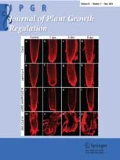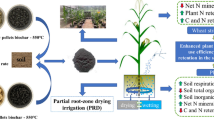Abstract
Although amending biochar into agricultural soils has been regarded as an effective measure to improve crop productivity, it remains unclear why biochar increases crop yield. The objective of this study was to compare the relative contribution of different biochar components in crop growth promotion. Three biochar components were separated: (i) water-soluble biochar extract (BE), (ii) mineral nutrients from biochar ash (BA), and (iii) washed biochar residue (WB). Two soils (Anthrosol and Primosol) with distinctly different organic carbon content, soil texture and land use were amended with the three biochar components and their effects on maize (Zea mays L.) growth were tested in a pot experiment. We hypothesized that (1) plant grown in the Anthrosol benefitted more from the water-soluble compounds of biochar than from its mineral nutrients or washed residue, since the soil is already fertile and has a good structure; (2) plant grown in the Primosol benefitted more from the mineral nutrients of biochar and its washed residual, since the soil is nutrient-poor and has a poor structure. The addition of biochar and its three components increased maize aboveground biomass for both soils. In the Anthrosol, BE, BA, and WB increased the aboveground biomass by 41.6%, 32.7%, and 27.1%; in the Primosol, they increased the aboveground biomass by 41.3%, 24.4%, and 18.2%, respectively. BE had the highest plant growth-promoting effect compared to the other two biochar components, which was regardless of soil condition. In addition, the biomass, total volume, surface area, and number of maize root tips under BE amendment were significantly enhanced, particularly the fine roots (< 0.2 mm in diameter). And a strong positive correlation was observed between maize aboveground biomass and the total length of the fine roots. The results demonstrated that the water-soluble compounds present in biochar, in addition to the mineral nutrients and the washed biochar residue, dominate the plant growth promotion under both soil conditions.




Similar content being viewed by others
References
Backer R, Ghidotti M, Schwinghamer T, Saeed W, Grenier C, Dion-Laplante C, Fabbri D, Dutilleul P, Seguin P, Smith DL (2019) Getting to the root of the matter: water soluble and volatile components in thermally-treated biosolids and biochar differentially regulate maize (Zea mays) seedling growth. PLoS ONE 13(11):1245–1249
Backer R, Saeed W, Seguin P, Smith D (2017) Root traits and nitrogen fertilizer recovery efficiency of corn grown in biochar-amended soil under greenhouse conditions. Plant Soil 415(1–2):465–477
Begum P, Ikhtiaria R, Fugetsu B, Matsuokab M, Akasakab T, Watarib F (2012) Phytotoxicity of multi-walled carbon nanotubes assessed by selected plant species in the seedling stage. Appl Surf Sci 262:120–124
Bian R, Li L, Shi W, Ma B, Joseph S, Li L, Liu X, Zheng J, Zhang X, Chen K, Pan G (2018) Pyrolysis of contaminated wheat straw to stabilize toxic metals in biochar but recycle the extract for agricultural use. Biomass Bioenerg 118:32–39
Biederman LA, Harpole WS (2013) Biochar and its effects on plant productivity and nutrient cycling: a meta-analysis. GCB Bioenergy 5:202–214
Brodowski S, John B, Flessa H, Amelung W (2006) Aggregate-occluded black carbon in soil. Eur J Soil Sci 57(4):539–546
Bruun EW, Petersen CT, Hansen E, Holm JK, Hauggaard-Nielsen H (2014) Biochar amendment to coarse sandy subsoil improves root growth and increases water retention. Soil Use Manage 30:109–118
Calvo P, Nelson L, Kloepper JW (2014) Agricultural uses of plant biostimulants. Plant Soil 383(1–2):3–41
Chan KY, Van Zwieten L, Meszaros I, Downie A, Joseph S (2007) Agronomic values of greenwaste biochar as a soil amendment. Aust J Soil Res 45:629–634
E Y, Meng J, Hu H, Cheng D, Zhu C, Chen W (2019) Effects of organic molecules from biochar-extracted liquor on the growth of rice seedlings. Ecotox Environ Safe 170:338–345
Fan X, Xu J, Lavoie M, Peijnenburg WJGM, Zhu Y, Lu T, Fu Z, Zhu T, Qian H (2018) Multiwall carbon nanotubes modulate paraquat toxicity in Arabidopsis thaliana. Environ Pollut 233:633–641
Fu F, Li F, Kang S (2017) Alternate partial root-zone drip irrigation improves water–and nitrogen–use efficiencies of sweet-waxy maize with nitrogen fertigation. Sci Rep 7:17256
Ghidotti M, Fabbri D, Masek O, Mackay CL, Montalti M, Hornung A (2017) Source and biological response of biochar organic compounds released into water: relationships with bio-oil composition and carbonization degree. Environ Sci Technol 51(11):6580–6589
Jeffery S, Abalos D, Prodana M, Bastos AC, van Groenigen JW, Hungate BA, Verheijen F (2017) Biochar boosts tropical but not temperate crop yields. Environ Res Lett 12:053001
Khodakovskaya MV, Kim BS, Kim JN, Alimohammadi M, Dervishi E, Mustafa T, Cernigla CE (2013) Carbon nanotubes as plant growth regulators: effects on tomato growth, reproductive system, and soil microbial community. Small 9:115–123
Kochanek J, Long RL, Lisle AT, Flematti GR (2016) Karrikins identified in biochars indicate post-fire chemical cues can influence community diversity and plant development. PLoS ONE 11(8):e0161234
Kolton M, Graber ER, Tsehansky L, Elad Y, Cytryn E (2017) Biochar-stimulated plant performance is strongly linked to microbial diversity and metabolic potential in the rhizosphere. New Phytol 213:1393–1404
Liu X, Zhang A, Ji C, Joseph S, Bian R, Li L, Pan G, Paz-Ferreiro J (2013) Biochar’s effect on crop productivity and the dependence on experimental conditions-A meta-analysis of literature data. Plant Soil 377:583–594
Lou Y, Joseph S, Li L, Graber ER, Liu X, Pan G (2016) Water extract from straw biochar used for plant growth promotion: an initial test. Bio Resources 11:249–266
Lu R (2000) Methods of inorganic pollutants analysis. Soil and agro-chemical analysis methods. Agricultural Science and Technology Press, Beijing, pp 205–266
Major J, Rondon M, Molina D, Riha SJ, Lehmann J (2010) Maize yield and nutrient during 4 years after biochar application to a Colombian savanna Oxisol. Plant Soil 33:117–128
Olmo M, Alburquerque JA, Barrón V, del Campillo MC, Gallardo A, Fuentes M, Villar R (2014) Wheat growth and yield responses to biochar addition under Mediterranean climate conditions. Biol Fertil Soils 50:1177–1187
Omondi M, Xia X, Nahayo A, Liu X, Korai P, Pan G (2016) Quantification of biochar effects on soil hydrological properties using meta-analysis of literature data. Geoderma 274:28–34
Pitman RM (2006) Wood ash use in forestry-a review of the environmental impacts. Forestry 79:563–588
Rajkovich S, Enders A, Hanley K, Hyland C, Zimmerman AR, Lehmann J (2012) Corn growth and nitrogen nutrition after additions of biochars with varying properties to a temperate soil. Biol Fertil Soils 48(3):271–284
Rombola AG, Marisi G, Torri C, Fabbri D, Buscaroli A, Ghidotti M, Hornung A (2015) Relationships between chemical characteristics and phytotoxicity of biochar from poultry litter pyrolysis. J Agr Food Chem 63:6660–6667
Saletnik B, Zagula G, Bajcar M, Czernicka M, Puchalski C (2018) Biochar and biomass ash as a soil ameliorant: the effect on selected soil properties and yield of giant miscanthus (Miscanthus x giganteus). Energies 11:2535
Sohi S (2012) Carbon storage with benefits. Science 338(6110):1034–1035
Spokas KA, Baker JM, Reicosky DC (2010) Ethylene: potential key for biochar amendment impacts. Plant Soil 333:443–452
Spokas KA, Cantrell KB, Novak JM, Archer DW, Ippolito JA, Collins HP, Boateng AA, Lima IM, Lamb MC, McAloon AJ, Lentz RD, Nichols KA (2012) Biochar: a synthesis of its agronomic impact beyond carbon sequestration. J Environ Qual 41:973–989
Sun J, Drosos M, Mazzei P, Savy D, Todisco D, Vinci G, Pan G, Piccolo A (2017) The molecular properties of biochar carbon released in dilute acidic solution and its effects on maize seed germination. Sci Tot Environ 576:858–867
Van Zwieten L, Kimber S, Morris S, Chan KY, Downie A, Rust J, Joseph S, Cowie A (2010) Effects of biochar from slow pyrolysis of papermill waste on agronomic performance and soil fertility. Plant Soil 327(1–2):235–246
Viger M, Hancock Robert D, Franco M, Gail T (2015) More plant growth but less plant defense? First global gene expression data for plants grown in soil amended with biochar. Global Change Biol Bioenergy 7(4):658–672
Xiang Y, Deng Q, Duan H, Guo Y (2017) Effects of biochar application on root traits: a meta-analysis. GCB Bioenergy 9:1563–1572
Yang W, Li P, Guo S, Fan B, Song R, Zhang J, Yu J (2017) Compensating effect of fulvic acid and super-absorbent polymer on leaf gas exchange and water use efficiency of maize under moderate water deficit conditions. Plant Growth Regul 83:351–360
Zhang D, Yan M, Niu Y, Liu X, van Zwieten L, Chen D, Bian R, Cheng K, Li L, Joseph S, Zheng J, Zhang X, Zheng J, Crowley GM, Fabbri D, Masek O, Mackay CL, Montalti M, Hornung A (2016) Is current biochar research addressing global soil constraints for sustainable agriculture? Agr Ecosyst Environ 226:25–32
Acknowledgements
This work was financially supported by the Ministry of Science and Technology of China under the project of National Key Technology R&D Program (Grant Number 2015BAC02B01), by the National Natural Science Foundation of China (41501310 and 41471193), by the Fundamental Research Funds for the Central Universities (KYZ201622 and KJQN201670), and by the Global Environment Facility under the project of Biochar for Sustainable Soil Management (B4SS).
Author information
Authors and Affiliations
Contributions
XL and CL designed the experiment and CL conducted the experiment. CL and BS analyzed the samples. CL and XL drafted the manuscript. XZ, MD, LL and GP finalizing the manuscript.
Corresponding author
Ethics declarations
Conflict of interest
The authors declare that they no conflicts of interest.
Additional information
Publisher's Note
Springer Nature remains neutral with regard to jurisdictional claims in published maps and institutional affiliations.
Electronic supplementary material
Below is the link to the electronic supplementary material.
Rights and permissions
About this article
Cite this article
Liu, C., Sun, B., Zhang, X. et al. The Water-Soluble Pool in Biochar Dominates Maize Plant Growth Promotion Under Biochar Amendment. J Plant Growth Regul 40, 1466–1476 (2021). https://doi.org/10.1007/s00344-020-10203-3
Received:
Accepted:
Published:
Issue Date:
DOI: https://doi.org/10.1007/s00344-020-10203-3




